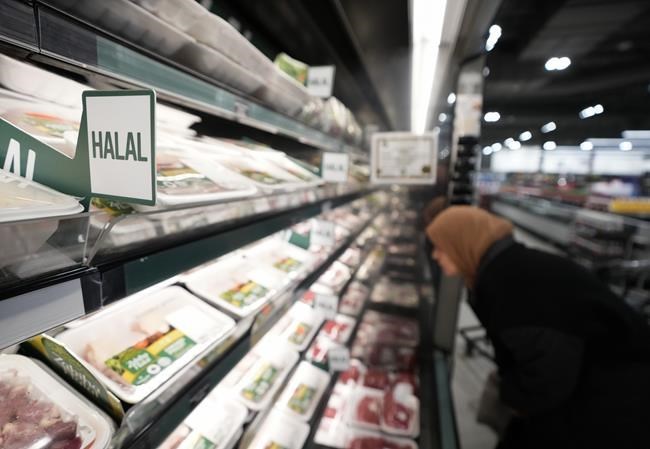Eleven years ago, the recipe for the McCain DeepŌĆÖn Delicious cake ŌĆö a decades-old Canadian classic ŌĆö changed.┬Ā
To many Canadians, the removal of beef gelatin from the cakeŌĆÖs components may have gone unnoticed. But for Muslim shoppers used to checking the ingredients of food products, it was cause for celebration.┬Ā
ŌĆ£It went kind of viral within the Muslim community, like, ŌĆśOh my God, we can eat this,ŌĆÖŌĆØ said Salima Jivraj, account director and multicultural lead at Nourish Food Marketing.
It's easier than ever to find halal meat, snacks and desserts in grocery stores as the industry expands in response to sa╣·╝╩┤½├ĮŌĆÖs growing Muslim population, and Jivraj said she doesnŌĆÖt expect that growth to slow anytime soon.┬Ā
ŌĆ£The demand just keeps growing. So itŌĆÖs a really good business to be in,ŌĆØ she said.┬Ā
Nearly five per cent of Canadians are Muslim, according to the 2021 census, a proportion that has more than doubled since 2001, with immigration as a key driver.
Almost 19 per cent of immigrants admitted between 2011 and 2021 were Muslim, Statistics sa╣·╝╩┤½├Į data show.
ŌĆ£Because the demand is there, the industry is paying more attention, and as a result thereŌĆÖs more products hitting the shelves,ŌĆØ said Omar Subedar, an imam as well as COO and co-founder of the Halal Monitoring Authority (HMA).┬Ā
For meat to be halal, the animal needs to be slaughtered in a certain way and blessed at the time of slaughter, he explained. Muslims donŌĆÖt eat certain kinds of meat, most notably pork, and the treatment of the animal from the beginning of its life is also important, he said.┬Ā
ItŌĆÖs not only about meat, however. Many common grocery items include animal byproducts such as gelatin (in marshmallows, for example) or rennet (found in many cheeses), said Jivraj. But these items are also increasingly available halal, she added.
Halal consumer packaged goods or other food products also need to be free of alcohol.
The HMA launched in 2006 to address malpractice and fraud in the halal food industry, said Subedar. It certifies halal-labelled products and monitors the practices of the companies it certifies.┬Ā
Mississauga, Ont.-based Maple Leaf Foods, which produces a variety of meat and other protein products, has seen rising demand for its halal offerings in recent years. The company's halal brand, Mina, was launched in 2013 and is certified by the HMA.┬Ā
"We expect strong growth to continue in the years to come," Patrick Lutfy, the company's senior vice-president of retail marketing, said in an emailed statement.┬Ā
There are significantly more options now for Muslim consumers in grocery stores and at restaurants than there were when Subedar was growing up. He remembers his mother making pizza at home with naan because he couldnŌĆÖt have pizza at a chain restaurant like many of his friends could.
ŌĆ£Look at how far weŌĆÖve come,ŌĆØ he said. ŌĆ£Now weŌĆÖve got a multitude of different options.ŌĆØ┬Ā
Much of the innovation in halal food can be found in smaller, independent and specialty grocery stores, not to mention an often much wider selection, said Jivraj. Those stores tend to understand their customer base better and are more nimble as well, she said.┬Ā
But over time, the big retailers have also realized they need to invest more in halal products, Jivraj said.
Nourish has been conducting a regular survey of Canadian halal consumers since 2016. The 2022 study found that more and more major food companies are meeting the needs of shoppers looking for halal products, with big box stores becoming a larger part of halal consumersŌĆÖ grocery shopping.┬Ā
The study also found that the Muslim community are savvy online shoppers, said Jivraj, which represents a challenge for independent stores ŌĆö and an opportunity for the major grocery chains, which invested heavily in e-commerce during the pandemic.┬Ā
Metro Inc., one of sa╣·╝╩┤½├ĮŌĆÖs largest grocers, has seen a ŌĆ£considerable increaseŌĆØ in demand for halal meat, said spokeswoman Stephanie Bonk. As a result, the grocer has dedicated more in-store space to halal products with a much larger assortment, she said, and halal products have experienced double-digit growth in recent years.
When Jivraj started blogging about halal restaurants in Toronto more than a decade ago, there were far fewer options ŌĆö and even those that called themselves halal couldnŌĆÖt always be trusted, as there was some fraud along the supply chain.┬Ā
Jivraj said thereŌĆÖs a lot more trust in the halal food industry today than there was when she first began blogging about it. One thing thatŌĆÖs contributed to this is an increasing amount of transparency when it comes to labelling halal products, she said.
In 2016, The Canadian Food Inspection Agency started enforcing new halal labelling and advertising requirements. All halal claims must be accompanied by the name of an organization or person that certified it as halal.
Since the CFIAŌĆÖs change, more organizations have popped up to fill demand for halal certification, said Subedar. However, itŌĆÖs not a perfect system since those organizations arenŌĆÖt regulated themselves, he said.┬Ā
Fraud is still a problem in the halal food industry, according to Subedar. He cautioned consumers to do their research when they see a product labelled as halal, and get to know how different organizations do their certification.┬Ā
Nevertheless, this move by the CFIA has been helpful for the consumer, said Subedar.
ŌĆ£Before, you can just write halal and no one can really question you,ŌĆØ he said. ŌĆ£But now thereŌĆÖs an authority or an organization behind it.ŌĆØ┬Ā
This report by The Canadian Press was first published Jan. 14, 2024.
Rosa Saba, The Canadian Press



